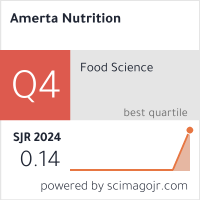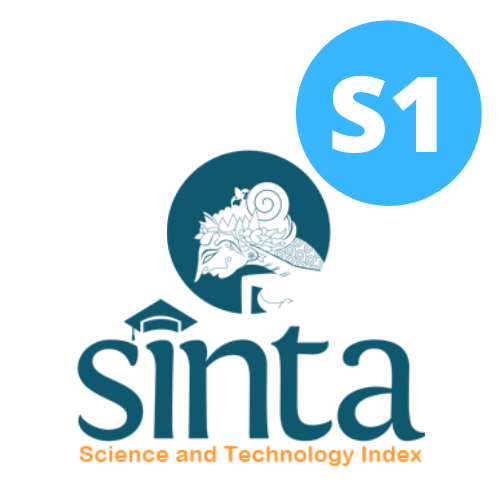Breastfeeding on Body Composition in Premature Infants: A Systematic Review
Pemberian ASI terhadap Komposisi Tubuh pada Bayi Prematur: A Systematic Review

Downloads
Background: Premature newborns have a higher susceptibility to metabolic syndrome and cognitive impairment compared to infants born at full term. Breast-feeding is advised as a natural source of nutrition for premature newborns and as a cost-effective approach to decrease illness and financial strain. Assessing preterm children's growth and body composition upon leaving the hospital is crucial and requires great attention due to its sensitivity and significance in determining future care.
Objectives: This study aimed to compare the body composition of preterm infants who were fed breast milk against formula.
Methods: This study employed a systematic survey approach, which involved the use of fifteen exploratory diaries covering the period from 2013 to 2023. The search terms employed were "breast-feeding", "body composition", OR "preterm infants".
Discussions: Breast-feeding preterm infants has a positive correlation with the deposition of body fat-free mass. This helps maintain healthy body composition, prevent obesity, prevent loss of brain cell development, and promote optimal growth instead of formula feeding. The body composition of premature newborns undergoes alterations during breast-feeding at ages that correspond to their expected due dates, which may contribute to the mitigation of risk factors associated with metabolic syndrome.
Conclusions: Breast-feeding preterm infants results in slower weight gain compared to formula feeding. However, it is more effective in repairing body composition by increasing body fat-free mass, which leads to better metabolic outcomes and neurodevelopment. The care of preterm newborns places a high priority on promoting breastfeeding and providing breastfeeding support.
INTRODUCTION
From the moment of birth, breast milk is the optimal nourishment that mothers can provide to their infants. Breast milk provides sufficient nutrients to fulfil the dietary requirements of infants up to six months old. Furthermore, breast milk is enriched with antibodies that bolster infants' immune systems, aiding them in combatting infections. Exclusive breast-feeding can enhance the bond between mother and child, expedite postpartum weight loss for the mother, and normalize the menstrual cycle. Increasing the number of moms who breastfeed could potentially increase the number of mothers who breastfeed1.
Preterm birth refers to the delivery of a baby before 37 weeks of gestation and is the primary factor contributing to neonatal mortality2. Based on data from the World Health Organization (WHO), roughly 13.4 million babies were born prematurely in 2020, meaning they were delivered before 37 weeks of gestation. Complications from preterm delivery are the leading cause of death for children under the age of 5, resulting in around 900,000 deaths in 2019. The prevalence of preterm births varied between 4% and 16% across different countries in the year 20203. Preterm newborns experience incomplete organ development, known as organogenesis, due to the unnatural conditions they encounter in the neonatal intensive care unit (NICU) during hospitalization. As a result, they face a significant risk of developing multiple health conditions4;5. A significant amount of research indicates that breastfeeding breast-feeding substantially impacts the growth and development of body composition in the early postnatal period6. There are multiple advantages to breastfeeding premature children, such as decreased sepsis rates, enhanced eating, increased neurodevelopment, decreased rates of metabolic syndrome, and reduced levels of low-density lipoprotein in adolescence7.
Having a thorough understanding of breastfeeding is crucial for adopting effective methods to enhance the body composition and growth of preterm infants, given their delayed postnatal development and body composition after hospital release8. Breastfeeding is a potential strategy to reduce neonatal mortality by promoting the mother's and newborn's well-being, preventing infections and problems, and fostering a strong bond between them. Breast-feeding is crucial for all infants, particularly those born prematurely, during the first six months of life. Premature infants face a higher risk of mortality and have unique challenges compared to full-term infants. Therefore, it is essential for mothers to closely monitor their babies' well-being and any factors that may impact breastfeeding. A lack of information or a mother's perspective in providing care can contribute to their concerns. In the early stages of infancy, newborns are more susceptible to experiencing weight loss and an elevated likelihood of developing disabilities9.
Understanding the typical age at which most preterm newborns achieve various nursing milestones, along with an individual evaluation, is a crucial resource for assisting mothers in breastfeeding their infants and promoting breastfeeding in preterm infants. Consequently, the authors undertook a systematic review with the objective of acquiring information about the impact of breast-feeding on the body composition and growth of premature newborns.
METHODS
A comprehensive review was conducted to analyze data from observational studies, including cross- sectional, case-control, and cohort designs. The search results of primary research were described using the Preferred Reporting Items for Systematic Review and Meta-Analysis (PRISMA) technique. The search was carried out between March and May 2023. The OR/AND/NOT Boolean operators were utilized to identify studies containing the keywords "OR", "AND", "body composition", "preterm infants", or "breast-feeding". The search was limited to studies published in English and Indonesian within the past ten years (2013-2023) and with an observational study design.
The article inclusion criteria were used to examine formula-fed preterm infants and formula-fed hospitalized newborns. Articles that are being examined for elimination should have the exact same content. A total of 8,410 articles pertaining to the specified keywords were discovered through an exhaustive search of electronic databases. A total of 434 publications were collected after excluding duplicate articles spanning a period of 10 years, which did not include full text or research articles. A total of 26 pertinent publications were chosen for the step of selecting titles and abstracts. A total of fifteen papers that satisfied the inclusion and systematic review criteria were deemed acceptable. The subsequent phase was the data extraction procedure, wherein significant information from the articles was gathered. The findings of the systematic review were thereafter displayed in a tabular manner as the outcomes of the data-gathering process. The table contained the researcher's name, study aims, research design, sample characteristics, findings, and conclusions.
Figure 1.PRISMA flow chart for 2020 to determine a systematic review of breastfeeding on the body composition of prematurely born infants
DISCUSSIONS
Effect of Breastfeeding on Body Composition of Premature Infants
Premature babies have a higher likelihood of experiencing poor neurodevelopmental outcomes. The long-term outcomes are greatly impacted by proper growth and nourishment. During the initial months after birth and in the prenatal stage, the development of the brain is influenced by the consumption of ideal nutrition. Over the past decade, there has been a growing fascination with dietary interventions aimed at promoting growth and development in preterm newborns11. Gianni et al.6 conducted a study to examine the influence of nursing on the accumulation of fat and fat mass in preterm newborns. A favorable link was discovered between the consumption of breast milk and the deposition of adipose tissue mass, which was further enhanced after adjusting for
Diwani, E. I. Z. Perbandingan Antara Perkembangan Bayi Usia 0-6 Bulan. (2022).
Zulaikha, N. & Minata, F. Analysis of Determinants of The Incidence of Premature Birth at RSIA Rika Amelia Palembang. JKSP 4, 24–30 (2021).
WHO, UNICEF & UNFPA. Born too soon Decade of action on preterm birth. (2023).
Msall, M. E., Sobotka, S. A., Dmowska, A., Hogan, D. & Sullivan, M. Life Course Health Development Outcomes After Prematurity: Developing a Community, Clinical, and Translational Research Agenda to Optimize Health, Behavior, and Functioning. in Handbook of Life Course Health Development 321–348 (Springer International Publishing, 2018). doi:10.1007/978-3-319-47143-3_14.
Vogel, J. P. et al. The global epidemiology of preterm birth. Best Pract Res Clin Obstet Gynaecol 52, 3–12 (2018).
Giannì, M. L. et al. Does human milk modulate body composition in late preterm infants at term-corrected age? Nutrients 8, (2016).
Amissah, E. A., Brown, J. & Harding, J. E. Protein supplementation of human milk for promoting growth in preterm infants. Cochrane Database of Systematic Reviews vol. 2018 Preprint at https://doi.org/10.1002/14651858.CD000433.pub2 (2018).
Amalia, L. & Herawati, E. Hubungan Pengetahuan dan Sikap Dalam Pelaksanaan Perawatan Metode Kangguru. Jurnal Pendidikan Keperawatan Indonesia 4, (2018).
Dwi Yitna Putri, M., Studi, P. S., Fakultas Ilmu Kesehatan Universitas, K. & Yogyakarta, A. PEMBERIAN ASI PADA BAYI DENGAN KELAHIRAN PREMATUR (Breast Milk in Babies with Prematur Birth). 5, (2022).
Murakami, E., Shionoya, T., Komenoi, S., Suzuki, Y. & Sakane, F. Cloning and characterization of novel testis-Specific diacylglycerol kinase η splice variants 3 and 4. PLoS One 11, (2016).
Ikatan Dokter Anak Indonesia. KONSENSU : Asuhan Gizi pada Bayi Prematur. (2016).
Piemontese, P. et al. The effect of human milk on modulating the quality of growth in preterm infants. Front Pediatr 6, (2018).
Morlacchi, L. et al. Protein use and weight-gain quality in very-low-birth-weight preterm infants fed human milk or formula. American Journal of Clinical Nutrition 107, 195–200 (2018).
Mól, N., Zasada, M. & Kwinta, P. Does type of feeding affect body composition in very low birth weight infants? – A prospective cohort study. Pediatr Neonatol 60, 135–140 (2019).
Belyaeva, I. A., Namazova-Baranova, L. S., Tarzyan, E. O., Skvortsova, V. A. & Boldakova, I. A. Peculiarities of Physical Growth and Body Composition of Preterm Infants, Received Different Types of Feeding, at the discharge from hospital [2 nd developmental care stage]. (2014).
Yangmei Li, X. L. N. M. S. U. Impact of breast milk intake on body composition at term in very preterm babies: secondary analysis of the Nutritional Evaluation and Optimisation in Neonates randomised controlled trial. ADC Fetal & Neonatal 104, 306–312 (2019).
Uauy, R. & Koletzko, B. Defining the nutritional needs of preterm infants. World Rev Nutr Diet 110, 4–10 (2014).
Wibowo, T., Anggraini, A., Safrida, E. N., Wandita, S. & Haksari, E. L. Lama Pemberian Air Susu Ibu pada Bayi Kurang Bulan dan Faktor yang Memengaruhi. Sari Pediatri 24, 294 (2023).
Underwood, M. A. Human Milk for the Prematur Infant. Pediatric Clinics of North America vol. 60 189–207 Preprint at https://doi.org/10.1016/j.pcl.2012.09.008 (2013).
Brownell, E. A. et al. Dose-response Relationship between Donor Human Milk, Mother’s Own Milk, Preterm Formula, and Neonatal Growth Outcomes. J Pediatr Gastroenterol Nutr 67, 90–96 (2018).
Amalia, M. Faktor-Faktor Yang Mempengaruhi Lama Rawat Inap Hospitalisasi Bayi Prematur. vol. 9 (2022).
Wisnu Hendrarto, T. & Ayu Nurahma, W. Pengaruh Asupan Gizi pada Bayi Prematur dengan Pertumbuhan Ekstrauteri Terhambat di Rumah Sakit Anak Bunda Harapan Kita. vol. 22 (2020).
Visuthranukul, C., Abrams, S. A., Hawthorne, K. M., Hagan, J. L. & Hair, A. B. Prematur small for gestational age infants fed an exclusive human milk-based diet achieve catch-up growth without metabolic consequences at 2 years of age. Arch Dis Child Fetal Neonatal Ed 104, F242–F247 (2019).
Gates, A., Marin, T., Leo, G. De & Stansfield, B. K. Review of Preterm Human-Milk Nutrient Composition. Nutrition in Clinical Practice vol. 36 1163–1172 Preprint at https://doi.org/10.1002/ncp.10570 (2021).
Arslanoglu, S. et al. Fortification of human milk for preterm infants: Update and recommendations of the European milk bank association (EMBA) working group on human milk fortification. Frontiers in Pediatrics vol. 7 Preprint at https://doi.org/10.3389/fped.2019.00076 (2019).
Fenton, T. R. et al. Validating the weight gain of preterm infants between the reference growth curve of the fetus and the term infant. BMC Pediatr 13, (2013).
Copyright (c) 2024 Amerta Nutrition

This work is licensed under a Creative Commons Attribution-ShareAlike 4.0 International License.
AMERTA NUTR by Unair is licensed under a Creative Commons Attribution-ShareAlike 4.0 International License.
1. The journal allows the author to hold the copyright of the article without restrictions.
2. The journal allows the author(s) to retain publishing rights without restrictions
3. The legal formal aspect of journal publication accessibility refers to Creative Commons Attribution Share-Alike (CC BY-SA).
4. The Creative Commons Attribution Share-Alike (CC BY-SA) license allows re-distribution and re-use of a licensed work on the conditions that the creator is appropriately credited and that any derivative work is made available under "the same, similar or a compatible license”. Other than the conditions mentioned above, the editorial board is not responsible for copyright violation.












































